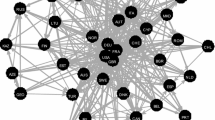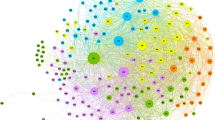Abstract
Using data published in UNESCOStatistical Yearbooks (1972 & 1991) on the 50 countries with the largest number of exchange students, this article describes the international student exchange network and its changes between 1970 and 1989. The results indicate that the network changed significantly over this 20-year period. While the United States and some Western developed countries have remained at the center of the network, Asian and Middle Eastern countries have become more central and African countries have become more peripheral. The role of colonial and linguistic factors has become less important, while economic development has a more important role in international student exchanges. The international student exchange network suggests an academic hegemony consistent with that of economics and politics. The changes of the network reflect the hierarchical structure of the hegemonic powers in the modern world system.
Similar content being viewed by others
References
Aldendefer, M.S. and Blashfield, R.K. (1984).Cluster Analysis. Beverly Hills, CA: Sage.
Altbach, P.G. (1990). Impact and adjustment: Foreign students in comparative perspective.Journal of Education and Social Change, 1–32.
Altbach, P.G., Kelly, D.H., and Lulat, Y.G-M. (1985).Research on Foreign Students and International Study. New York: Praeger Publishers. Altbach, P.G. and Wang, J. (1989).Foreign Students and International Study. National Association for Foreign Student Affairs: University Press of America.
Barber, E.G., Altbach, P.G., and Myers, R.G. (1984).Bridges to Knowledge. Chicago: University of Chicago Press.
Barnett, G.A., Jacobson, T, Choi, Y., and Sun, S. (1993, May). An examination of the international telecommunications network. Paper presented at the International Communication Association, Washington.
Borgatti, S., Everett, M., and Freeman, L. (1992).UCINET IV: Network Analysis Software. Columbia, SC: Analytic Technologies.
Bradshaw, Y. (1991). Intensifying global dependency: Foreign debt, structural adjustment, and third world underdevelopment.Sociological Quarterly 32, 321–342.
Chase-Dunn, C. (1989).Global formation: Structures of the world-economy. London: Basil Blackwell.
Chase-Dunn, C. (1992). Theoretical approaches to World-Systems Analysis. In C. Polychroniou (Ed.),Perspective and Issues in International Political Economy. New York: Praeger. 3–20.
Chirot, D. and Hall, T. (1982). World-system theory.Annual Review of Sociology 8, 81–106.
Clark, C. and Merritt, R. (1987). European community and intra European communications: The evidence of mail flows. In Cioffi-Revilla, Merritt, and Zinnes (Eds.),Communication and Interaction in Global Politics. Newbury Park, CA: Sage Publications. 209–235.
Cummings, W.K. (1984). Going overseas for higher education: The Asian Experience.Comparative Education Review 28, 241–257.
Cummings, W.K. (1993). Global Trends in Overseas Study. In C.D. Goodwin (Ed.),International Investment in Human Capital: Overseas Education for Development. New York: Institute of International Education. 31–46.
Frank, A.G. (1979).Latin America: Underdevelopment or Revolution. New York: Monthly Review Press.
Fry, G.W. (1984). The Economic and political impact on study abroad. In Barber, E.G., Altbach, P.G., and Myers, R.G. (Eds.),Bridges to Knowledge. Chicago: University of Chicago Press. 55–72.
Goodwin, C.D. (1993). (Ed.).International Investment in Human Capital: Overseas Education for Development. New York: Institute of International Education.
Kick, E. (1983). World-system properties and military intervention-internal war linkages.Journal of Political and Military Sociology 11, 185–208.
Kick, E. (1987). World-system structure, national development and the prospective for a socialist world order. In T. Boswell and A. Bergesen (Eds.),America's Changing Role in the World System. New York: Praeger. 127–155.
McMahon, M.E. (1992) Higher education in a world market: An historical look at the global context of international study.Higher Education 24, 465–482.
Mitchell, J. (1974). Social network.Annual Review of Anthropology 3, 279–299.
Olson, W. and Groom, A. (1991).International Relations Then and Now. London: Harper Collins Academic.
Richards, W.D. Jr. (1989).The NEGOPY Network Analysis Program. Burnaby, BC. Department of Communication, Simon Fraser University.
Richards, W.D. Jr. and Rice, R.E. (1981). NEGOPY Network analysis program.Social Networks 3, 215–233.
Rogers, E.M. and Kincaid, D.L. (1981).Communication Networks: Toward a New Paradigm for Research. New York: Free Press.
Schott, T. (1993). World science: Globalization of institutions and participation.Science, Technology, and Human Values 18, 196–208.
Shannon, T.R. (1989)World System Perspective. San Francisco: Westview Press.
Sirowy, L. and Inkeles, A. (1984). University-level student exchanges: The U.S. role in global perspective. In Barber, E. G. (Ed.),Foreign Student Flows. New York: Institute of International Education. 29–85.
Smith, D. and Nemeth, R. (1988). An empirical analysis of commodity exchange in the international economy: 1965–80.International Studies Quarterly 32, 227–240.
Smith, D.A. and White, D.R. (1992) Structure and dynamics of the global economy: Network analysis of international trade 1965–1980.Social Forces 70(4), 857–893.
Snyder, D. and Kick, E. (1979). Structural position in the world system and economic growth, 1955–1970: A multiple-network analysis of transnational interactions.American Journal of Sociology 84, 1096–1126.
Sun, S. and Barnett, G.A. (1994). An analysis of the international telephone network and democratization.Journal of the American Society for Information Science 45, 411–421.
Sutton, F.X. (1993). The world in 1990s. In C.D. Goodwin (Ed.),International Investment in Human Capital: Overseas Education for Development. New York: Institute of International Education. 9–30.
UN (1989).National Accounts Statistics: Analysis of Main Aggregates, 1988–1989. USA: author.
UNESCO (1972).Statistical Yearbook. Paris: author.
UNESCO (1991).Statistical Yearbook. Paris: author.
Wallerstein, I. (1974).The Modern World System. New York: Academic.
Wimberley, D. (1990). Investment dependence and alternative explanations of third world mortality: A cross-national study.American Sociological Review 55, 75–91.
Author information
Authors and Affiliations
Rights and permissions
About this article
Cite this article
Barnett, G.A., Wu, R.Y. The international student exchange network: 1970 & 1989. High Educ 30, 353–368 (1995). https://doi.org/10.1007/BF01383539
Issue Date:
DOI: https://doi.org/10.1007/BF01383539




